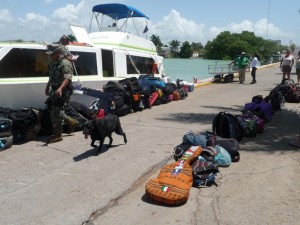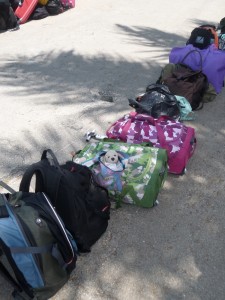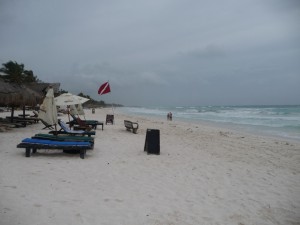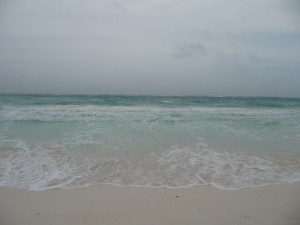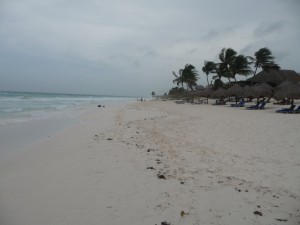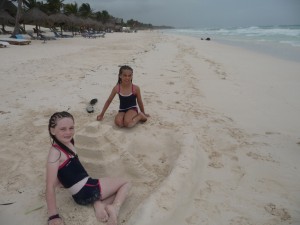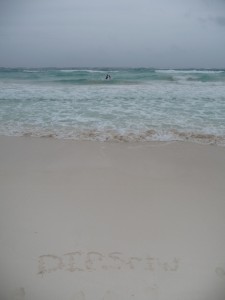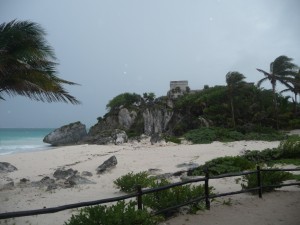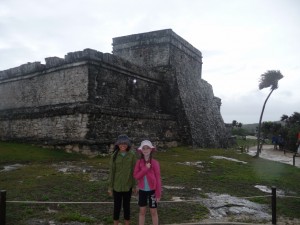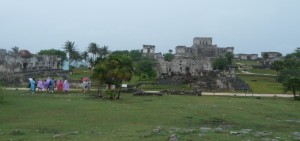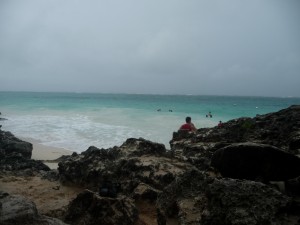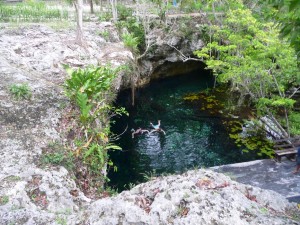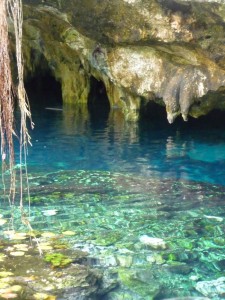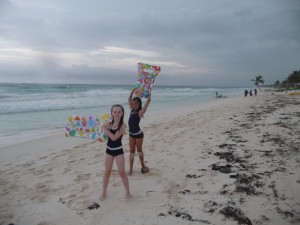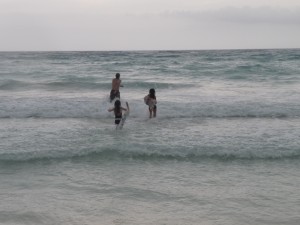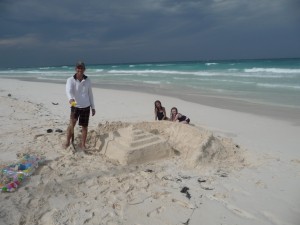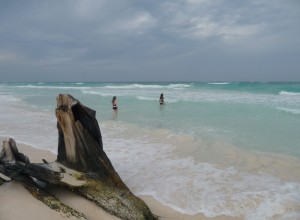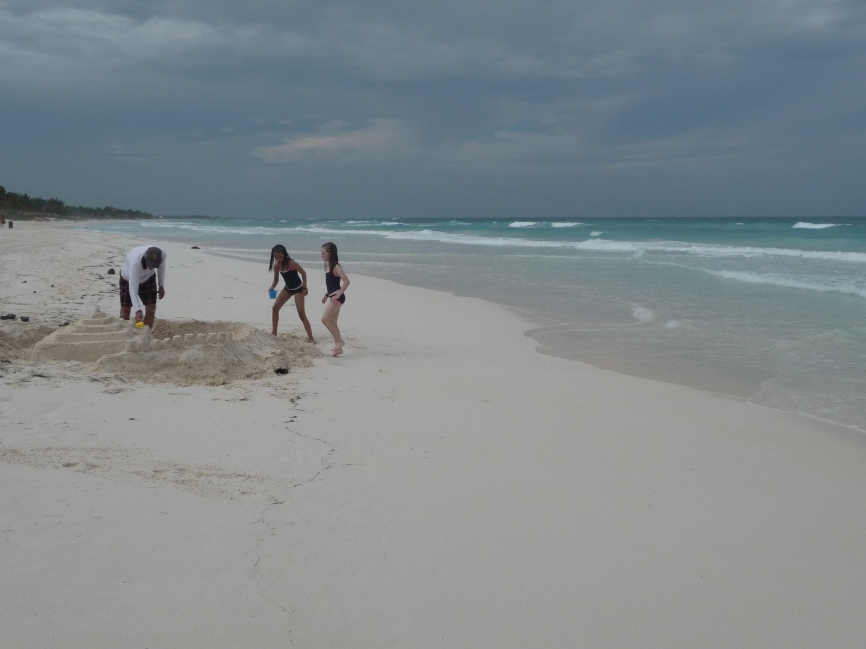DIPS in the Mexican Riviera – Tulum
Posted by asuasu69 on Jun 10, 2013 in Guatemala, Mexico | 0 commentsThe Mexican government had organised a welcoming committee for our arrival at the seaside town of Chetumal in the form of armed guards and a sniffer dog. Actually, we didn’t feel that special as this is standard for all boats arriving at the port. Central America and Mexico are part of the super-highway for the drugs making their way from the producers in South America to the users in the US. Along the wharf, more armed guards sat in high speed recon boats, ready should any suspicious craft be spotted in Mexican waters. Our bags were removed from the boat and laid out in a row on the dock together with hand luggage.
The black Labrador very casually walked up and down the line of luggage and paid a little attention to the bags, but did stop to lick ‘Scruffy’ who was poking out of Immis’ bag.
After completing immigration formalities, we take a taxi direct to the bus station and book on the next bus to Tulum, a seaside town located three hours north on the Mexican Riviera. 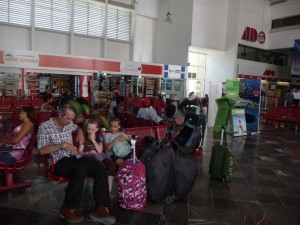 The Mexican ADO buses are luxurious compared to our other bus experiences in Central America. Modern, air conditioned coaches with drop down screens showing movies. Three and a half hours and another taxi ride later, and we arrive at our hotel: ‘Las Palmas Maya’.
The Mexican ADO buses are luxurious compared to our other bus experiences in Central America. Modern, air conditioned coaches with drop down screens showing movies. Three and a half hours and another taxi ride later, and we arrive at our hotel: ‘Las Palmas Maya’.
With four standard rooms, one suite (ours for the next week) and a communal kitchen, the hotel is located behind the beachfront hotels that occupy the prime positions, but we are still less than a two minute walk from the white powder sand beach and clear waters of the Caribbean Sea.
We spend some mornings sitting in the kitchen and common area doing schoolwork, and afternoons on the beach building Mayan pyramid sand castles (some beach walkers even stopped to photograph it on their way past), and playing in the surf with the girls becoming quite adept at body surfing. The sand is so fine and white and on close inspection with little flecks of pink.
The Tulum Mayan seaside ruins are only a 10 minute taxi ride up the coast road, so we head off early one morning to beat the daily tour buses that visit every day to disgorge hoards of tourists from cruise ships and resorts that are everywhere on this coast. The sky was overcast when we set off from our hotel and it pretty much bucketed down while we were there, saturating us. We wander around the area enclosed by a protective stone wall that was once the main trading, administrative and religious centre for the city.
The main temple is perched on a cliff top overlooking the sea and to one side is what was once a very small harbour used for loading and unloading the canoes that transported goods up and down the coast. The little harbour has long since filled with sand and is now cordoned off as turtles use it for their nests. It is a spectacular site for a Mayan city – but apparently the only one built on the coast – if I had to live in any Mayan city this one would have been the pick.
The Tulum ruins have their own style of architecture and, as with all the Mayan cities, the residents were very focused on astrology. As Tulum has an unobstructed view to the east, this city was particular in tracking the movements of Venus. After walking around the ancient city, we descend the sturdy timber steps to a small beach directly below the main temple and enjoy a swim. The girls loved playing in the surf and are reluctant to leave. The water is a perfect temperature and enough surf that you have to remain vigilant unless you want a dumping.
Another day we are able to enjoy two attractions in one day by hiring a taxi and driver and making our way north of Tulum about 25 kilometres to another seaside resort area called Akumal. Here we again don our Wal-Mart goggles and snorkels (they have really paid for themselves by now!) and swim off the beach to look at some typical Caribbean coral and fish life. We leave all our belongings (including camera) in the car as we are told to walk up the beach and follow the roped area back so can’t leave anything on the beach unattended.
The lagoon between the reef and beach is only about 200 metres wide and does not get much deeper than about 2 metres. The area is well set up with floating ropes for nervous tourists and first time snorkelers to pull themselves around. This particular beach is unique as it also has an area of seagrass just off the beach where you are able to watch as green sea turtles graze. Akumal means ‘place of the turtles’ in the Mayan language, and we are able to get close to four adults who seem to get mildly annoyed at all the attention they receive while trying to grab a quick feed. A Mexican lunch consisting of fish tacos and burritos at the beachside restaurant follows our swim, then it’s back to our waiting taxi.
The next stop is at the Gran Cenote which is back close to the outskirts of Tulum. Before arriving in Mexico we had never even heard of a cenote before and yet they are everywhere here. The whole of the Yucatan Peninsula was once a seabed for an ancient ocean that covered the area. A very thin veneer of topsoil, usually less than 0.5m thick, now covers the limestone beneath that was left when the water receded. The shells and coral of this seabed have now become the limestone foundation for the entire peninsula.
A cenote is a subterranean cave which has formed below ground as fresh water dissolves the limestone over thousands of years, and they often fill up with crystal clear fresh water. The Mayan believed cenotes were the openings to the underworld, and often left sacrifices (animal and human) inside the entrances. Whilst they vary greatly in size, this area in Mexico boasts the largest cenotes in the world, and there are hundreds, perhaps thousands of them, dotted around the peninsular. They are popular for swimming, snorkelling and cave scuba diving, and they are also the source of fresh drinking water in many towns and villages.
After swimming in the ocean, we still have that sticky/salty feeling on our skin, so a dip in the cool fresh water at this cenote is welcome. Small fish and tortoises inhabit the water and stalactites and stalagmites of all shapes and sizes are clearly visible underwater.
We snorkel around for an hour or so and explore some of the cave openings that we can get to with just a mask and snorkel. The water is amazingly clear and it is quite surreal swimming and diving around the stalagmites and stalactites. As always, the girls are more interested in the animal life and prefer to watch the tortoises as they lazily cruise in the shallows.
Once again, the desire for freedom of movement under our own steam meant we would investigate the possibility of hiring our own car versus getting a driver and car or taking the bus to get around and see the sights. Some on-line research revealed that driving in Mexico is relatively safe, apart from the crooked cops and their bogus speeding fines and bowser jockeys at all the petrol stations who have invented cunning ways to fool you into parting with your hard-earned pesos.
We hired a Nissan Tida (small four door, automatic) for USD 340 for the week. The girls loved their time on the beach so much that we extended our stay in Tulum by one day so the last day there was no school work scheduled leaving more beach time before packing the car and heading inland.
Our plan was to use the Spanish colonial town of Valladolid as our base to explore some more of the Maya ruins and cenotes in the area before making our way to Playa del Carmen for the final two nights in Mexico and departure through Cancun.

